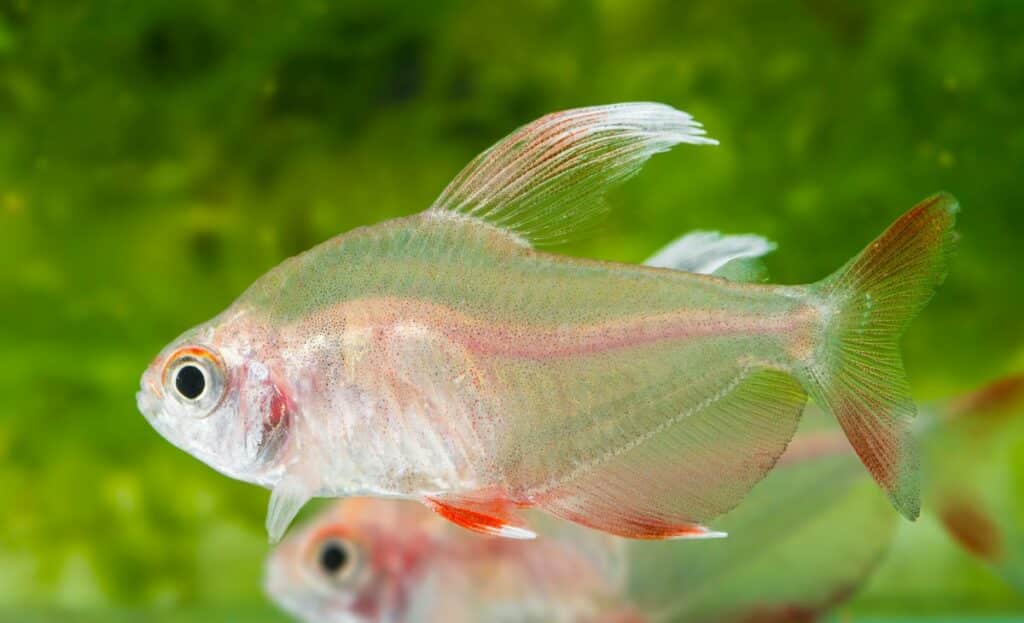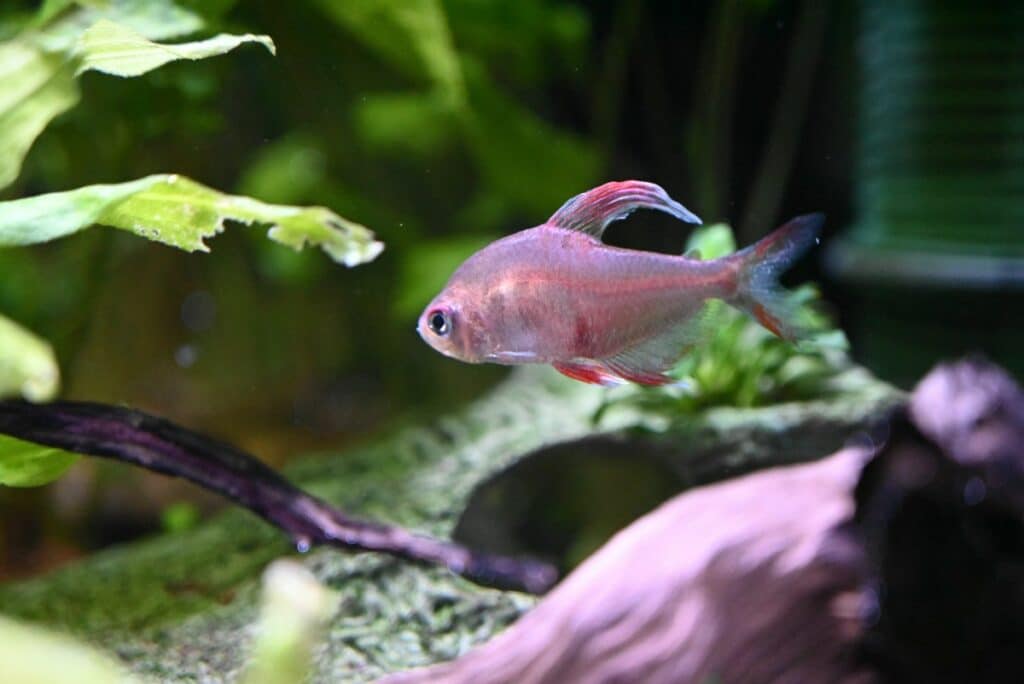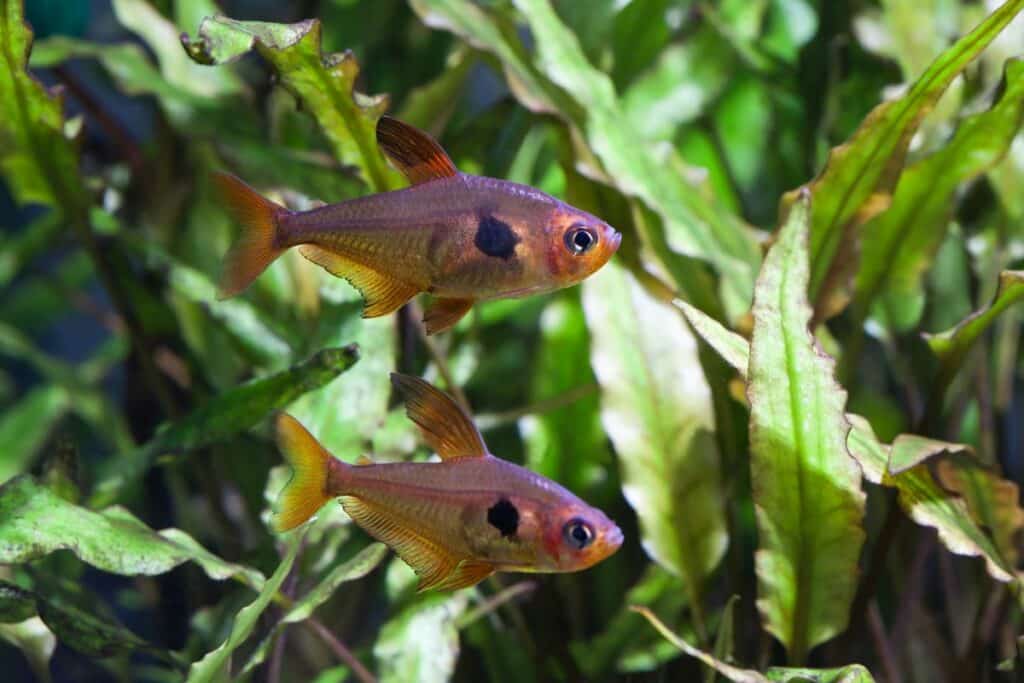the essentials in brief
Depending on the species, the jewelry tetra grows to around 3 to 4 cm.
The ornamental tetra gets along well with other tetra species or peaceful ornamental fish such as neon tetras, harlequin barbs, platies or guppies. Read more here...
The jewelry tetra is very durable and can live up to 10 years. Read more here...
Are you looking for an easy-care and sociable fish for your aquarium? Then jewelry tetras might be just the thing for you. These small tetra species come from South America and delight with their bright coloring and their peaceful behavior. In this blog post you will learn everything you need to know about keeping, feeding and breeding tetras.
What are jewelry tetras?

Jewelry tetras belong to the family of Tetras (Characidae) and to Genus Hyphessobrycon. There are several types of jewelry tetras that vary in size, shape, and color. The best known are the Rose Tetra (Hyphessobrycon rosaceus) and the Sickle tetra (Hyphessobrycon bentosi).
Both species are about 3 to 4 cm long and have an elongated, laterally flattened body. The basic color is usually pink or red, the fins are orange or yellow. The dorsal fin is long in males and has a dark spot. Their anal fin extends to the base of the caudal fin.
Additional information: Coral tetras are very long-lived fish that can live up to 10 years. They are also very fertile and can spawn several times a year.
Jewelry tetras are very adaptable and resilient. They can cope with different water values as long as the water is clean and low in nitrates. They prefer a temperature of 23 to 27 ° C, a pH from 5,5 to 8,5 and a total hardness of 2 to 20 °dH.
Ornate tetras are omnivores that eat both plant and animal food. They like to eat live or frozen food such as mosquito larvae, artemia or daphnia.
How do you set up an aquarium for jewelry tetras?
Tetras are schooling fish and should be kept in groups of at least 6 to 10 animals being held. For such a group is an aquarium with a edge length of 60 cm sufficient. The aquarium should be set up with a dark substrate and loose planting.
Tip: You can use soft water to bring out the colors of the jewelry tetras even better. You can achieve this with peat or alder cones, for example.
There should be enough swimming space for the agile fish. Some roots or stones can serve as hiding places. The light should not be too bright, as tetras tend to be active at dusk.
What other fish do tetras get along with?
Ornate tetras are very peaceful and sociable fish that get along well with other tetra species or peaceful ornamental fish. You can take them with you, for example neon tetras, harlequin barbs, platies or guppies socialize
Note: Ornate tetras sometimes pluck or nibble on the fins of other fish. This is usually not a sign of aggression, but of curiosity or boredom. To avoid this, you should offer your ornamental tetras enough variety in the aquarium.
But make sure that the other fish are not too big or too aggressive, otherwise the tetras can be stressed or injured. Also make sure that the water parameters and temperature are suitable for all fish.
How do I breed jewelry tetras?
Breeding tetras is not very difficult if you keep a few things in mind. First, you should set up a separate breeding tank of at least 20 liters. The water should be soft, acidic and warm (about 26 to 28 °C).
The tank should be sparsely planted, for example with java moss or hornwort. These plants serve as spawning substrate and as protection for the young fish. The tank should also be darkened, since tetras like to spawn at dusk.
In order to increase the willingness of the tetras to spawn, you should feed them plenty beforehand feed with live or frozen food. Then you can place a pair or a small group of tetras in the breeding tank. You can tell the sexes by the shape of the dorsal fin: the males have a longer and more pointed dorsal fin than the females.
After a short time, the ornamental tetras begin to spawn between the plants. They give up to 300 eggs that stick to the plants.
Attention: Coral tetras are very sensitive to medications containing formalin or malachite green. These can damage their mucous membrane or even be fatal. Therefore, only use medication that is specifically designed for tetras.
After spawning, the parents should be removed from the rearing tank, otherwise they could eat the eggs or the young fish. The young fish hatch after about 24 hours. The young fish are initially very small and feed on their yolk sac. After about three days you can feed them fine dust food or infusoria.
Later you can also feed artemia nauplii or microworms. The juveniles grow quickly and can be transferred to the main tank after about six weeks.
What diseases can tetras get?
Although silvered tetras are hardy and resilient fish, they can sometimes get sick. The most common diseases in jewelry tetras are

Mouth or fin rot: This bacterial infection manifests itself as a white, cotton-like covering on the mouth or fins. The affected fish become apathetic and eat poorly. Treatment is with a suitable antibiotic.
fungal infections: These are usually caused by poor water quality or injuries. They are noticeable by grey, fluffy patches on the skin or gills. Treatment is with an antifungal agent.
Tip: In order to prevent diseases in tetras, you should always ensure that the water is of good quality and carry out regular water changes. In addition, you should always keep new fish in a quarantine tank before adding them to your jewelry tetras.
velvet disease: This parasitic disease is caused by a unicellular organism called Oodinium. It manifests itself as a golden-brown, velvety covering on the skin, which is particularly visible against the light. Infested fish will chafe against objects, breathe rapidly, and lose their color. Treatment is with a copper preparation.
fish tuberculosis: This bacterial infection is very dangerous and contagious for fish and humans. It is manifested by emaciation, ulcers, goggle eyes or curvature of the spine. Treatment is usually futile and requires quarantine or euthanasia of the diseased fish.
Ornamental tetras are ideal aquarium fish
Silvered Tetras are a group of small and colorful species of tetras native to South America. They are very easy to care for and robust because they can adapt to different water parameters. They are omnivores, eating both plant and animal food. They are schooling fish that should be kept in groups of at least 6 to 10 individuals. They are very peaceful and social, getting along well with other tetra species or peaceful ornamental fish.


